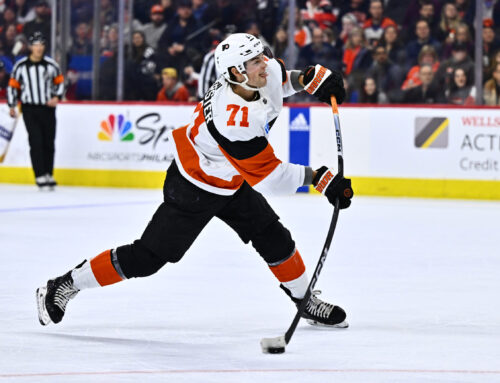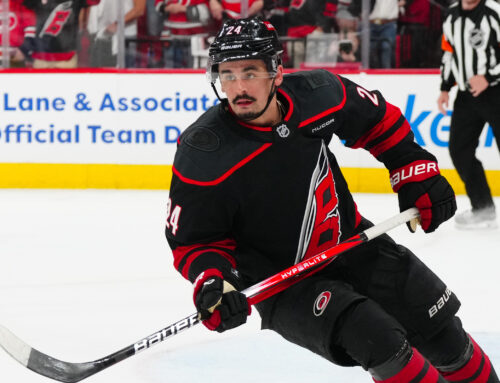In this week's Eastern Edge, we'll look at players riding hot streaks across the conference. I used Dobber's Frozen Tools to come up with this list of players and I can't express how useful the platform is. In addition to hot/cold streaks, you can look at line combinations and how certain players perform against certain opponents, as well as player usage charts to understand if a player's deployment allows them to score more easily. Check it out for yourself over here!
Thomas Chabot
The 24-year-old defenseman had a modest start to the season, posting seven points in his first 15 games. He's been excellent since then, tallying 12 points – all of which have been assists – in his last 10 appearances. This increased production seems to be a product of the team's improved offense. During that first stretch of 15 games, Ottawa averaged 2.13 goals a night. Only Detroit (2.06) and Anaheim (1.93) averaged fewer goals in that timeframe. In contrast, Ottawa has a top-10 offense over that second stretch, during which they've scored 3.33 goals per game.
I mentioned how all of Chabot's recent points have been assists. Seeing as Drake Batherson has been scoring at a crazy rate recently – posting eight goals in his last 12 games – I wondered if Chabot's assists were largely a product of Batherson's goal-scoring tear. In short, the answer is no – Chabot has assists on goals scored by a wide variety of players. Of those 12 recent assists, three came from goals scored by Evgeny Dadonov, two from each of Connor Brown, Colin White, and Brady Tkachuk, and one from each of Tim Stützle, Ryan Dzingel and Drake Batherson. In other words, Chabot's recent production is more a result of his own strong play than Batherson's hot streak, making it more sustainable as the season progresses.
Despite Chabot's recent hot streak, his power-play production remains unimpressive. He has just four points with the man advantage through 25 games. It's not for lack of opportunity either as he sees 70-percent of the team's total power-play time. Ottawa just isn't very good with the man advantage, sporting a success rate of 14.4-percent through 28 games. Despite the team's lack of success, I think it's reasonable to expect more power-play production from Chabot. Batherson plays on the same unit and has managed eight points with the man advantage through 28 games. Hopefully Chabot factors into the power-play offense a bit more going forward.
The Rangers power forward has been on a tear with 11 points in his last eight outings – including two hat tricks. That represents an incredible bounce back performance as he had just five points in his first 15 games of the season. It's worth noting that Panarin has been out of the lineup for seven of the eight games comprising Kreider's hot streak. Kreider has shown an increased willingness to shoot in Panarin's absence, averaging 2.44 shots per game without the Russian superstar and 1.93 shots with him.
Kreider's recent production is partially fueled by New York's improved power-play. The team converted on 12.3-percent of their opportunities during their first 15 games – back when Kreider was struggling offensively. He had two points with the man advantage during that stretch. In contrast, the Rangers sport a 22.2-percent success rate over their last eight games, where Kreider has four PPPs. At even strength, the 29-year-old forward has mostly played alongside Ryan Strome during this hot streak. Strome has seen similar offensive success recently, posting 10 points in his last eight outings.
Kasperi Kapanen
Kapanen needed some extra time to adjust in Pittsburgh after his Penguins debut was delayed due to visa issues. The speedy winger started slowly with six points in his first 11 games but followed that up with a point-per-game pace over his next 10 outings. Again, that improvement is partially explained by gradual adaptation to the pace of play after an extended offseason. However, he was also playing with different line mates between that first and second stretch. He started off beside Evgeni Malkin and Jason Zucker, both of whom struggled offensively as the season got underway. During that second stretch, he spent most of his minutes beside Sidney Crosby and Jake Guentzel – who have produced much more consistently this year. It is worth mentioning that Malkin has found his offensive form recently, tallying 11 points in his last 10 appearances after posting seven in his first 14. That is relevant because Kapanen was playing beside Malkin again during Pittsburgh's last game against the Rangers.
Montreal's top line of Brendan Gallagher, Phillip Danault and Tomas Tatar performed below standards this season, but they've started to look dangerous again under the guidance of Dominique Ducharme. Despite a lack of offensive production this season, the underlying numbers always supported their effectiveness as a unit. Even under Claude Julien, they controlled 60-percent of the shot-share, generating twice as many scoring chances and high danger opportunities as their opponents. They've managed similar numbers under Ducharme, but they seem to be playing with more confidence and the puck is finally starting to go in. Tatar leads the team with seven points in six games since Ducharme took over. Gallagher has been similarly hot with six points in the same span. However, Danault only has two points. The difference seems to be power-play production as Gallagher and Tatar have two and four power play points respectively during this stretch.
Alex Burrows deserves credit for turning the Canadiens' power-play around. In six games under his guidance, Montreal leads the league with a 45.5-percent success rate – scoring on 5 of 11 opportunities. It's worth noting that Tatar's improved power-play production isn't a product of an increased role. He's seen a 40-percent share of the team's time with the man advantage under both coaches. I don't think Tatar can maintain such a high level of PP production in such a limited role. However, as the season progresses, I think the trio of Tatar, Gallagher and Danault will score more at even-strength, offsetting any decline in Tatar's power-play scoring.





 CHI
CHI N.J
N.J MTL
MTL CBJ
CBJ BOS
BOS PIT
PIT DET
DET ANA
ANA L.A
L.A COL
COL S.J
S.J
